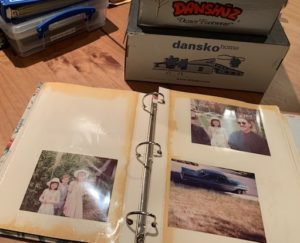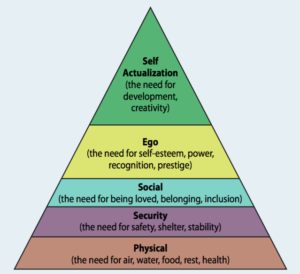Sheltering at Home, Week One
 The first week of sheltering at home, I thought “This is great – I’ll have time to do all those things I’ve been putting off. I unearthed a photo album from the 1980s that I wanted to bring up to date for my step-daughter’s 40th birthday. Two shoeboxes of photos from her childhood needed sorting into chronological order and sticking in the album.
The first week of sheltering at home, I thought “This is great – I’ll have time to do all those things I’ve been putting off. I unearthed a photo album from the 1980s that I wanted to bring up to date for my step-daughter’s 40th birthday. Two shoeboxes of photos from her childhood needed sorting into chronological order and sticking in the album.
Once I had those on the dining room table, I went back to the closet to put it back in order. Then I sat on the couch and surfed Netflix for a cheerful movie.
I sat on that couch for the rest of the week.
From the end of January, when the first case of Coronavirus appeared in California, through March 4, when the first death in California was attributed to Covid19, I lived my life as if nothing was happening. Looking at my day planner, I see that I met with my writing group on the Santa Cruz Wharf on March 2, then went to vote. We reconvened that evening to share our writing and watch the election returns. I volunteered in an elementary classroom on March 4, went to my massage therapist on March 5, and spent the afternoon of March 6 with my granddaughter.
Then events began to be canceled. My monthly book group; a legislative training in Washington D.C.; a highly anticipated visit to my youngest daughter and granddaughter in Arlington. “Mom, it’s too dangerous. Stay home.” A Bunco fundraiser for one of my professional organizations. A photoshoot for my press packet. Even my daughter’s birthday party.
When my granddaughter’s school shut down, I began working out a new schedule so I could spend more time with her the following week while her mother worked. Her mother, however, behaved like the grown-up she is and urged me to self-quarantine. She and her partner would take care of Bean. “Too risky, Mom. She might be a carrier.” Not see Bean? I felt like I’d been punched in the gut. Now the quarantine was Real.
Thus the couch. And Netflix. And, to be truthful, a little too much wine.
Week Two
But the following week, I was back at my desk, revising a chapter of a book I hope to republish. I typed reassuring messages to my online students who were now facing, not just one online class, but all of their college classes being converted into online platforms. I called my age-mates in far off cities with cheerful messages – “We can do this,” we told one another.
I started back on my photo album project.
My daughters were learning how to home-school their children, my pastor was figuring out how to stream a Sunday service, my writing coach was teaching herself how to lead a class on Zoom. Each of us was trying to maintain a normal schedule in the middle of far-from-normal circumstances.
And some of us failed. By March 21, the day we were supposed to be celebrating Jamie’s birthday, I was back on the couch.
Does this sound familiar?
Before you beat yourself up for spending too much time watching movies and reading Facebook posts, and failing to complete all the tasks you planned to do in March, read on.
Dr. Alisha S. Ahmad, assistant professor of political science at the University of Toronto, and author of Jihad & Co: Black Markets and Islamist Power, wrote about this very experience in the March 27 issue of The Chronicle of Higher Education. She has lived under conditions of war, violent conflict, poverty and disaster in many places around the world. She’s been confined to her rooms and experienced long periods of social isolation and restricted movement. She has also conducted research and written scholarly articles under those conditions, and observed many others doing the same. During that process, she identified three stages of mental and emotional adjustment to chaos, and I share them with you here.
Stage 1 – Security
Most of my family and friends jumped into the fray quickly, once we saw what was happening. There may have been some denial at first (“It’ll be over in a month.”), but after we faced up to the truth, we began stocking up on food, bleach, alcohol wipes and Purel, if we could find it. Oh, and toilet paper. My son sent me a photo of a larder bursting at the seams, with case lots of staples filling all the countertops in his kitchen. A friend made a last visit to Costco before isolating herself, filling two grocery carts with staples. I started waking up at 3:00 a.m., trying to think of all the things I would need to make it through the next few months.
Ahmad said this is normal. 
So did Abraham Maslow, who devised a theory known as the Hierarchy of Needs. He observed that before people can be productive, or even sociable, they need to secure the basic human needs, food, clothing, safety, and shelter. This level, Physical, is at the foundation of the triangle
“Your first priority during this early period,” Ahmad wrote, “should be securing your house. Get sensible essentials for your pantry, clean your house, and make a coordinated family plan.” It’s important to figure out how you will stay connected to family, friends, work, religious community, and neighborhood, while maintaining the physical distance recommended by public health workers. Identify people who are vulnerable and need to have others helping them. If you’re vulnerable yourself, figure out who can help you obtain food, prescriptions, cleaning supplies.
Many people alive today have never experienced a disaster of this magnitude. It may have taken them longer to comprehend what was happening, and what was needed to combat the virus. And even if they are beginning to get it, they may still be wallowing in denial or disbelief. We need to give them space and time to do the mental and emotional work of coming to grips with a new reality.
Stage 2 – The Mental Shift
Once you have secured your home and your family, you have moved up to the Security level on Maslow’s hierarchy. Your mind and body will begin to adjust and you will begin to crave social interaction. That’s when you can reach out to friends and family. Maslow wrote that we have a need to feel loved, to be accepted and included. Staying connected to loved ones can be crucial as our moods cycle up and down. Pick up the phone and call an old friend; write cheery notes; send emails to colleagues working from home.
And now you can return to the tasks you’ve set aside. Whether it is a quilt project, keeping the books for a local hardware store, or working on your doctoral dissertation, now you are prepared to go back to it. Maslow calls this level Ego, the need for self esteem, power, recognition, and prestige.
However, there may still be a period of adjustment. It’s hard to feel recognized and appreciated when you are working alone at home. Many of my friends are writers, as I am, and we have been gathering on Zoom to support one another’s efforts. I’ve heard frustration from my wordsmith friends. “I don’t have anything to say.” “My project no longer seems relevant.” “I just don’t feel like writing.”
Several writers I know put their big projects on hold and scribbled ferociously in their journals. Some wrote poetry, and posted it on Instagram. I handwrote a dozen letters on old-fashioned notepaper and sent them around the world, telling my friends I was thinking about them.
Some of us turned to cooking, baking, staging meals in different parts of the house, with candles and placemats and three desserts. Just because we could. We had plenty of food. We had plenty of time. My son set up a hibachi on his patio and roasted marshmallows with his daughter. After my stepdaughter went on a laundry marathon and found herself with four empty laundry baskets, her four-year-old turned them into a jungle gym. We can learn from the little ones how to make the best of our new normal.
Stage 3 – Embrace a New Normal
Because that’s what it is. For the foreseen future, anyway. We might as well embrace it and make it work. This experience will change how we think, how we see the world, and how we will choose to be productive. Once we have stabilized, life at home will start to feel more natural. Ahmad suggests that once we have set up our home for the long term, we should create a weekly schedule that includes work, play, physical movement, and communicating with others. Go to bed at the same time each night. Get up at the same time in the morning. Take showers. Dress in real clothes. Get out of the bathrobe or sweats, except for your Zoom yoga class. Note to me: hold off on that glass of wine until 5:00 p.m. The final step on Maslow’s pyramid is Self Actualization. We may not reach the be-all and end-all of existence while we are sheltering in place, but we can settle into equilibrium. We can feel comfortable, and we can once again be productive.
Week 3
How’s it going for you? Can you identify these stages in the way you and your family have been behaving, and feeling? For me, I’ve discovered that I don’t much like exercises on video, but I force myself to participate in the Silver Sneakers class being streamed by my gym and I feel better after it. I don’t like being separated from my grandchildren, either, but I love talking with them on FaceTime. Listening to Willie Nelson while I vacuum makes that hated chore go more quickly, and listening to classical music in the afternoon soothes me while I knit, or sew, or read. I’m writing again – as shown by this essay – and I’m working on the photo album a little bit each day. My companion Border Collie, Kismet, enjoys our longer walks, as well as the doggie puzzles I fill with treats when I need a little space for a Zoom meeting. She thinks this having Mommy home all the time is great.
It’s not life as we knew it, but it’s our life for now. So let’s get off the couch and embrace it.
Let us know how you are adjusting to this new normal, using the comment form on my web page.
To receive my posts in your email whenever they are published, please type your email address into the subscription box on my web page. I promise, I’ll never send spam . . . Marlene
Share this post




What a good job of summing up the early weeks of Sheltering at Home. I seem to be moving up and down the pyramid, with days of being productive followed by days of spending non-quality time with my TV. It’s so helpful to read articles like yours and realize we’re all in this together.
Thanks for your insightful explanation of how we are feeling/acting/responding to our new normal. It does feel strange that our lives have changed forever, and in such a relatively short space of time.
Oh Marlene, what a treat to read this today! I’ve been beating myself up about doing pretty much nothing! Goodness knows, this is a perfect time. Though if I didn’t do it under my retired label, what’s the difference now?
Self-motivation is almost non existent.
We will get through this, and I hope globally the lessons we have been so clearly shown will be followed up on.
On a certain level i am totally befuddled at how a world that embraced ( and accomplished) walking on the moon, sending craft to mars, learned how to harness solar energy, wind energy, finds the keys to solve horrid diseases etc. could be so blind sided. The entire globe is experiencing this. The playing field of how this has hit is the same! It’s obvious, not all were hit the same. The degree to how much hit is taken has varied a bit. Germany and a couple of others are having a lighter ‘hit.’
But back to the psychological end of this, I find it interesting how the reactions are almost in our DNA. I find this really enlightening because so many of our population have never experienced hardships of this degree. I’m not discounting cultural, financial, any of the ills of our culture but those have been daily in their lives since birth.
I’ve rambled a bit. I’m not the wordsmith you are but I guess I just needed to connect with someone from our ‘younger years’. LOL a while ago right, but yesterday.
Thank you so much for sharing all the different mood swings we go through during this ‘shelter in home’ phase; I still find it hard to concentrate on any one project / chore for more than 20 minutes. Patience is my new motto. Larry and I do stick to some sort of a schedule with food, exercise, reading, tv and wine – hmmm our wine time has moved to 4:30 ! And yes our families were the ones to say ‘stay home! Don’t go out! We have finally complied. We do go for walks with our beautiful scenery. Together we will make this work.
Thanks for sharing this! At first, I found myself doing nothing much. Then, doing everything like there would be no tomorrow. Now, I sew/quilt a bit, do some housework, craft a bit and read. Missing seeing family and friends is difficult but knowing we are all safe and doing what’s best to stay that way makes it easier. Normal will never be what it was but we all look forward to getting past this and being together.